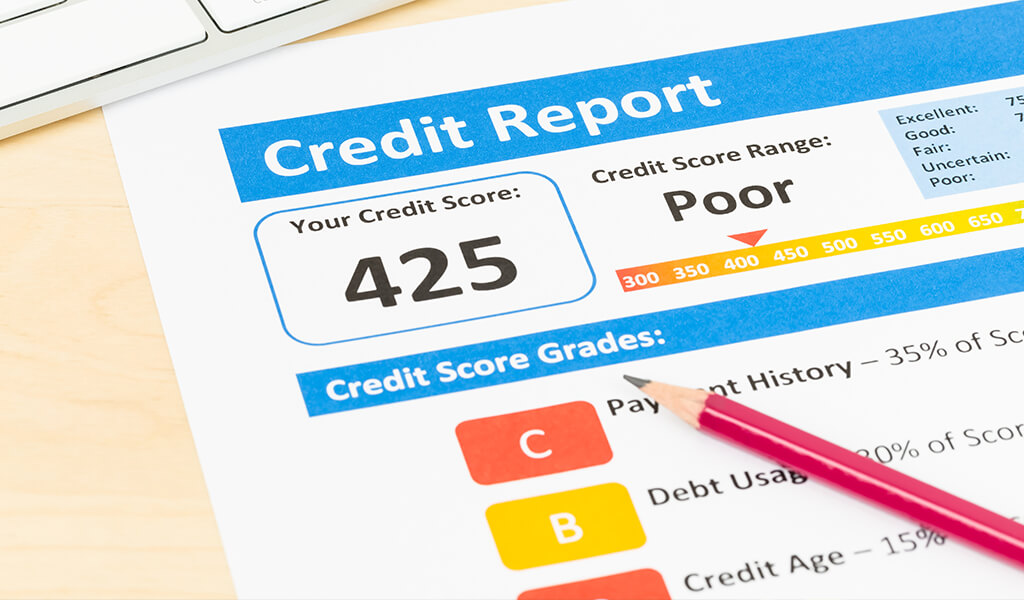Knowledge is power.
And when it comes to your credit report, knowledge is buying power.
That’s because your credit score not only impacts whether or not you get approved for financing to buy a truck or van but also several other factors tied to the cost of vehicle ownership, including the required down payment, interest rate (and, thus, monthly payment), and insurance costs.
Even if you could qualify to buy a truck with a below average credit score, it could still cost you hundreds of dollars (or more) per month, making it much more challenging to make money with that truck and build a sustainable business.
So, what can you do to build a credit history that strengthens your buying power?
Avoid these four mistakes with your credit.
Mistake #1. Sticking your head in the sand.
You might feel stressed out thinking about your credit, but you can’t improve what you don’t focus on. When you find out exactly where you stand with your credit report, you’ll know what you need to work on to raise your score.
How do you get a copy of your credit report without negatively impacting your score?
You can go directly to each of the main credit reporting firms where you’re entitled to one free credit report per year:
Also, most credit card companies give you free access to your credit score—and, in some cases, your full credit report—without lowering your score.
Mistake #2. Keeping high balances.
Credit utilization rate refers to the percentage of your credit card balances relative to your credit limit. The higher that percentage, the lower your credit score. That’s because if you’ve nearly maxed out your credit cards—say, for example, you’re at 85-percent of your total credit limit—you’re viewed as a much higher credit risk to lenders.
So, focus on paying down your balances to lower your credit utilization rate. Even reducing your ratio to under 50-percent could go a big way to help raise your score.
Mistake #3. Closing credit card accounts too soon.
You’ve paid off a credit card account. Congratulations! Should you go ahead and close that account?
Conventional wisdom would say, “Yes.” After all, you’ve paid off the balance and don’t want to be tempted to run up charges on that account again.
But you might want to hold off closing that account—at least for now.
Why?
Refer to the credit utilization rate, which we talked about above with Mistake #2: “Keeping high balances.”
Suppose that with all your credit cards, you have a combined credit limit of $10,000. And you’ve paid off two cards with a total limit of $5,000.
Your total credit card balance is $4,000.
If you keep the paid-off credit cards open for a total credit limit of $10,000, your credit utilization rate would be 40% ($4,000 out of $10,000).
But if you close the two cards, your total credit limit drops to $5,000.
Now, your $4,000 balance takes your credit utilization rate to 80% ($4,000 out of $5,000), which makes you appear to be a higher credit risk.
The ideal situation is to keep paying down your balances. And as those balances get lower, look at which credit card accounts you can close without making your credit utilization rate too high.
But if you keep paid-off accounts open, how can you ensure that you don’t run up those balances again?
Put those cards away or cut them up.
Mistake #4. Letting collections accounts linger.
The sooner you can get a collections account paid off, the sooner it will come off your report. So, do everything you can to keep it from lingering.
How?
Here’s your action plan:
- Get yourself onto a stronger cash-flow footing where you can start putting money into savings to use to pay off the collections.
- Contact the company that now owns the debt. You’ll find the creditor’s contact information on your credit report.
- Pay the balance owed.
If you can’t pay the full balance, the company might be willing to work out a payment plan with you.
Another option is to ask to speak with someone with the creditor who has the authority to negotiate a settlement of the debt at “less than the full balance.”
You don’t need to be a high-powered lawyer to negotiate this type of deal. That’s because the creditor most likely bought your debt for pennies on the dollar. So even collecting 25 or 30 percent of the full amount could be profitable for them, depending on the situation.
The upside to settling your debt for less than the full balance is that it will change the account status on your credit report from “charged off” or “collections” to “settled,” which could help improve your score. The downside is that the difference between the amount you owed and the lower amount you actually paid to settle the account could be considered as income for tax purposes. So, consult with a tax professional to assess the potential tax implications of settling the debt.
The Bottom Line
Even if you’ve experienced financial challenges that have damaged your credit, it doesn’t have to be the end of your dream of becoming a successful owner-operator or fleet owner. You just need more knowledge and visibility into your credit history. That’s because when you’re aware of the impact of your credit on your business costs, you’ll be more likely to develop—and act on—a plan that raises your credit score…and, ultimately, strengthens your buying power.
